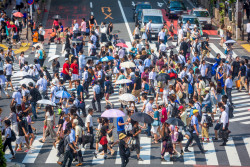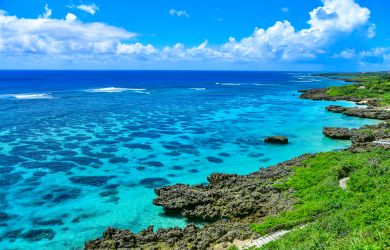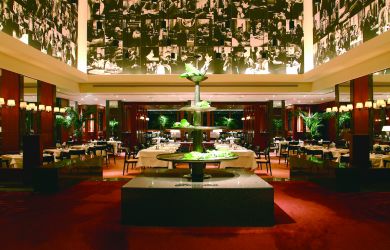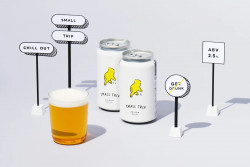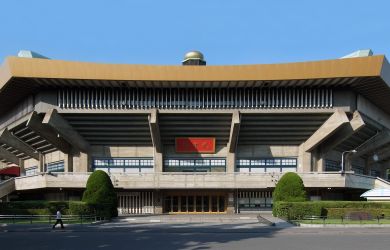
August 14, 2008
Air Fair
Fuel costs are sending airfares into the stratosphere. What’s a poor traveler to do?
By Metropolis
Originally published on metropolis.co.jp on August 2008

We have a look at some of these bargains being advertised by travel agents in magazines this summer: Los Angeles for ¥29,000, New York for ¥69,000, Sydney ¥34,000, Singapore ¥24,000, Seoul ¥19,000, London and Paris both for ¥59,800. Fantastic. What are you waiting for? Yet once you book your ticket, either at the travel agent or online, a nasty surprise awaits you: the fuel tax hasn’t been included in the price, and in most cases, that can mean an extra surcharge of anywhere from ¥25,000 to ¥50,000.
The situation is not going to get better anytime soon. Airlines are struggling to keep costs down, but as fuel prices continue to skyrocket, the carriers are forced to use any and all means to save money—adding the fuel costs to tickets, scaling back routes, and replacing aircraft. There was even a rumor in the US that some airlines were planning to reduce flying speed to save on fuel.
Being so far from Europe and the US, passengers in Japan are particularly feeling the pinch. Travel agents on the front line have to face fire-breathing passengers who suddenly find out that a ¥34,000 fare to Sydney is really ¥80,000. Although the fine print in most ads (but not all) does say that prices exclude taxes, that is of no consolation to consumers. In many other countries, it is a legal requirement for the advertised airfare to include all taxes and surcharges, but not yet in Japan. So the result is that many consumers take their anger out on the travel agent staff.
“The spiraling fuel prices have been in the news a lot recently, but many of our customers are still surprised when they hear how much they’ll have to pay for airfare,” said Motohisa Tachikawa, senior manager at the public relations department of JTB. “Some customers change their destination right there and then, since a closer destination won’t have as high a fuel surcharge.”
That charge is determined by the length of flight, said Wesley Stockstill, director of marketing and strategy for American Airlines in Tokyo.

Courtesy of American Airlines
“At American, what we spend on fuel as a company increases by approximately $80 million for every one dollar increase in price per barrel of [oil]… To give some perspective of the dramatic price increases, in January, 2004, oil was selling at $34.31 per barrel; in September, 2005 it was $66.91, and in mid-June, it closed above $135.”
Goldman Sachs forecast recently that crude oil could top $140 a barrel sometime this summer and hit $200 next year. Since fuel costs typically account for up to 40 percent of total operating expenses, that spells disaster for the industry. The likely impact is that it will result in a major shakeup, with weak airlines being downsized or restructured, while those in better shape financially opt to concentrate on their premium routes.
Among Japanese carriers, All Nippon Airways is already scaling back unprofitable domestic routes, said spokesman Rob Henderson. “We are making our point-to-point local network into a hub-and-spoke operation through major airports where routes have been cut. To reduce the inconvenience to our passengers, [we’re] making connecting times as short as possible and creating special connecting fares comparable to the cost of the suspended direct flights.”
Australian carrier Qantas is taking even more drastic action. In a statement to media in June, the airline said it cut costs by discontinuing or reducing a number of international services, mainly to Japan and Southeast Asia. Beginning September 1, it will cancel its thrice-weekly service between Tokyo and Melbourne and reduce the number of weekly return flights between Sydney and Tokyo to seven from nine. Qantas will also end Jetstar services from Cairns to Osaka and Nagoya in December. “At current fuel prices, the group would lose more than A$100 million (US$95 million) operating to Japan under our existing schedule,” Qantas CEO Geoff Dixon said in the statement. He added there would be a small number of jobs lost in Australia and Japan as a result of the changes.
ANA is trying other measures to cut costs, said Henderson. “We are investing in the latest, most efficient and environmentally friendly aircraft. ANA is the launch customer of Boeing’s 787 and Mitsubishi’s regional jet,” he said. “We regularly wash our engines with water to remove carbon deposits that reduce operational efficiency; we are altering our landing approach where possible… and we have introduced lighter, carbon fiber seating, lighter crockery and serving carts, and taken weight out of the cabin… Pilots also taxi with one engine as opposed to two. In short, we are exploring as many ways as possible to make savings wherever we can, without compromising safety.”

Photo by Chris Betros
One move that has gotten a lot of unfavorable publicity in the US is the decision by American, United, Continental, US Airways and Northwest to charge passengers an extra fee—ranging from $15
to $20—for their first checked bag. (Most US carriers already have instituted a $25 charge for checking a second bag.) United said in a statement that it expects to earn $275 million a year through baggage handling fees. Some airlines even charge extra for seat reservations—$5 for middle seats, $10 for window and aisle seats and $15 for exit-row seats.
Meanwhile, Virgin Atlantic is trying a novel approach: its fuel surcharge will differ depending on what cabin you are using. Economy class will receive the smallest increase, while premium economy and first class seats will be charged a higher fee. “Our upper class and premium economy passengers benefit from considerably more space on our aircraft and larger baggage allowances than our economy passengers, so our aircraft burn more fuel to carry them. We believe that economy passengers should pay lower fuel charges than passengers in our two premium cabins,” CEO Steve Ridgway told media.
In Japan, many airlines still pay ticketing fees to travel agents, but some carriers are starting to buck this custom. From October 1, Northwest said it will abolish the 5 percent fees it pays to travel agencies for air tickets issued in Japan, making it the first airline to do so here; American, United and Continental plan to lower their commission rates.
So what does all this mean for consumers? Are there bargains out there? Should one shop online or still go to travel agents? The industry is still considerably regulated by the government. JTB’s Tachikawa said ticket prices are decided every half-year-term (April-September and October-March). “The basic airfares cannot be changed once they are set, but surcharges can,” he said. “Right now, the travel agencies’ trade association wants the advertised airfare to include the fuel surcharge because that’s what customers want. The transport ministry is leaning toward that point of view and I think that by October 1, a new pricing system will be in effect.”
But the dangers remain. “There will still be risks for travel agents. We have to be careful how we advertise it, because the ‘sudden’ rise in airfares may dissuade a lot of people from traveling. There may be a drop at first, but we are positive because customers will know well in advance what the final fares will be.”
One service that will help Japanese consumers adjust to the new conditions is online ticketing, which still lags way behind the US. Because the Japanese government has been slow to liberalize airfares, it’s been cheaper to buy a ticket through a travel agent than directly from the airline. United, for example, sells about 90 percent of its tickets through agents.
This, however, is beginning to change, as the transport ministry implemented the first step toward price deregulation by abolishing restrictions for economy class fares on April 1. Prior to the change,
the ministry set minimum prices airlines could charge for departures from Japan. “Our cheapest fares are on offer on our website, and bookings made on it are subject to a discount, and generally they are the best value for consumers,” says ANA’s Henderson. “That said, [travel agents] do sometimes offer deals of their own—completely independently of the fares we put in the market—that may match or improve on our own.”
Some bright news for the industry, in Asia at least, is that people are still flying. Despite rising airfares, passenger traffic is up 5.9 percent so far this year, according to the International Air Transport Association. Nevertheless, most Asian carriers have announced cutbacks on long-haul routes. Cathay Pacific, Korean Air, Taiwan’s China Airlines, EVA Airways and Malaysian Airlines have all scaled back on their international routes, and are depending on premium short-haul runs within Asia.
In a bid to woo more passengers, some carriers are bucking the trend toward no-frills service by enhancing their in-flight offerings. On August 1, JAL launched its JAL Suite in first class (it looks like a mini-office) and the JAL Shell Flat Neo Seat. Customers flying on Air New Zealand’s Boeing 777 and 747 aircraft can now enjoy their personal seat-back entertainment system from the moment they sit down until the moment the aircraft lands. The service provides on average an extra hour of viewing time per flight, which helps passengers enjoy more of the 250-plus movies and TV programs,
and extensive CD library available on the system. United is adding iPod and iPhone connectivity to its list of in-flight entertainment.
The best advice that travel agents give to prospective travelers is to search hard on the internet, rethink your destination, act fast, avoid peak seasons and be flexible. Oh, and don’t forget the good old-fashioned trains and buses.
